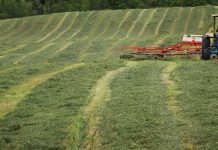A study was recently published in the Journal of Dairy Science summarizing the last 40 years of research on individual calf housing compared to either pair or group-housed calves. Over those 40 years, 81 peer-reviewed research studies have been conducted on these housing systems with 47 published journal articles. The study found that group-housed calves had significantly higher starter grain intake, higher average daily gain and heavier weaning weights.
Weight gain
When calves were weaned at 8 weeks of age, group housing increased average daily gain by 0.11 pounds per day on average compared to individually raised calves. When calves were weaned earlier than 8 weeks, the average daily gain increase was 0.17 pounds per day. Group-housed calves begin eating starter sooner and consume more pounds of starter. When weaning was over 8 weeks of age, the average daily gain increase was 0.13 pounds per day. Across all weaning ages pair or group housing increased weaning weights.
Social
Group housing also showed positive impacts on calf behavior. Group-housed calves had an increase in visits to consume starter and the amount of time spent eating. They also spend more time playing and interacting with other calves. Individually housed calves had a higher frequency of self-grooming which is a response factor to stress.
Some studies showed that the group-housed calves were less likely to interact with humans than the individually-housed calves. This decreased interaction did not have a negative response to human interaction later in the heifer’s development.
The social interaction of group housing decreases the time it takes for calves to learn new tasks as they copy their pen mates. It also improves the calves’ ability to interact with novel experiences later in life and not spook. The group-housed calves also exhibited higher vocalization frequency especially when separated from their pen mates, demonstrating that separation is stressful and that calves are motivated to seek social contact.
Illness
Unfortunately, these studies did not include a lot of information about calf illness based on group size and there were limited studies with groups over 15 calves. One study that compared groups of 6-9 calves to larger groups of 12-18 calves found higher incidence of respiratory illness and lower growth rates in the larger groups than the smaller groups. The larger groups showed increased competition for starter even when proper eating space was provided. A dominant calf chased the more timid calves away from feed.
Group size
Group size should also be determined based on the age spread of calves within the group. Keeping the age spread to seven days or less showed the least challenges with competition. Pair-housed calves did not show a decreased rate of grain when the age spread was more than 14 days but, larger groups showed a decreased rate of gain. When pair-raising or group-raising calves, the pairs should be kept together through the heifer-raising phase and at least one if not the entire group staying together to reduce future stress.
Barn design
Barn design and management for year-round air quality is critical for all calf-raising systems but even more critical for larger group-housed systems.
This past week has been a challenging time for calf barn ventilation with temperature swings of 50 degrees requiring curtains to be opened and closed daily on naturally ventilated barns. When temperatures fall below 50 degrees F, calves under a month of age begin to use additional energy to stay warm.
After a month of age, as calves begin to consume grain their lower critical temperature drops to 35 degrees F. For naturally ventilated barns, only eave and ridge ventilation should be left open. Lower curtains should be closed when temperatures fall below 50°F to protect calves from a draft.
Mechanical positive pressure ventilation can assist with winter calf health by moving a small amount of air at speeds of 50-60 feet per minute at 4 feet above the floor. This small amount of air movement cannot be felt but brings fresh air into the building that displaces damp air and pathogens. The goal is not to keep barns warm in the winter but to protect calves from a draft and maintain air quality.













